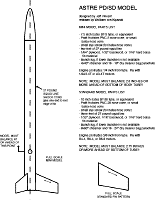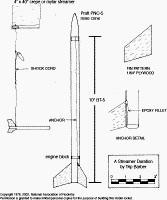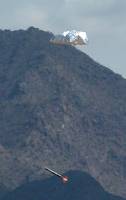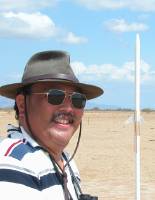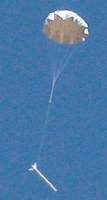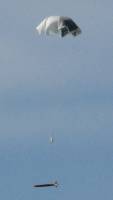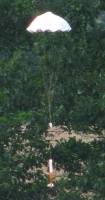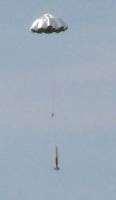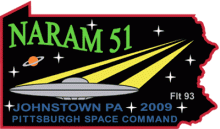 |
NARAM-51 Event Tips Pages (draft) |
 |
|
|
|
|
|
|
|
|
|
|
|
|
|
|
|
|
|
|
|
|
For NARAM-51, the Parachute Duration event is for 1/2A engine class, and is flown Multi-Round style. Parachute Duration combines the challenge of building a light rocket that can carry a large enough parachute to descend slowly, yet being able to deploy reliably, to achieve a good duratin score. In Parachute Duration, the model has to remain in one piece throughout the flight and cannot be staged. Multi-Round - This form of duration scoring involves "Max" times and three flights. For 12/A PD, the maximum time is 120 seconds. As an example, if the model stays in the air for 152 seconds, it's official time is 120 seconds ("Max"). It is a challenge to get a 1/2A PD model to stay in the air for at least 120 seconds, for three flights in a row. Usually thermal help is needed. Models in multi-round scored events DO NOT have to be returned, but only two models are allowed. This means that you need to return one model to make your third flight. And if you make it to a flyoff, you'll need a returned model for the fourth (flyoff) flight round. For the full rules for this event, please see the Parachute Duration Rules on the NAR web page, as well as the multi-round rules (15.12). Scoring - For Multi-Round Parachute Duration, the scoring is the sum of all of the qualified flights. If there is a tie for first place at the end of round three (normally three maxes), there will be a fly-off round between those contestants who are tied, with the max time increased by at least 60 seconds. Design considerations - There are trade-offs between the model's performance and the parachute's size. Increasing the size of the parachute means the chute will need more room inside your rocket. Increasing the size of the rocket to hold a larger chute will make the rocket heavier, so it will not boost as high. One of the biggest problems in flying PD is getting the chute to deploy. This is not just an issue of packing technique. It concerns how tightly packed the chute is inside of the tube. This is why some fliers will use a longer length tube, and/or a larger diameter tube, so they can have more room to pack a chute in. This also depends on the material used for the parachute, since thinner material packs more easily into a given tube length and diameter than a thicker material The simplest and perhaps best models for a new flier to make are 13mm type models, using a body tube of about 12" or so length. Then use whatever appropriate diameter of chute that you can pack into it that will DEPLOY reliably. Estes BT-5 kits that may be suitable are the Gnome and Puma, if you have them. But these are not as good as ones you can make, or as good as contest-type kits. A list of plans and kits is included further down on this page.
Parachutes - Parachute choice and preparation is important. A simple Estes type chute just is not going to perform very well. The plastic is very thick. For years, I have recommended 1/4 mil (.25 mil) Plastic Dropcloth for parachute material. It is very very thin, thinner than dry cleaner bags. But, it has become a lot harder to find .25 mil dropcloths the last few years. Perhaps in part because plastic that thin is terrible as a real dropcloth. Still, it is worth trying to find, because it packs so small. You might have to settle for a somewhat thicker dropcloth. Or, even go with plastic taken from cheap ponchos, though those are not nearly as good for 1/2A PD chutes (a good source for Eggloft Duration chutes, though). If you do use a dropcloth, one drawback is that it is clear, which can be hard to see (though you will want to use talcum powder on the chute, so it will not be totally clear but "frosty" looking). Before you use talcum powder, get a large black magic marker and use it to color part of the plastic to make it more visible. You could also use red, I like black for most sky conditions. A lot of fliers use 1/4 mil Mylar chutes. Those pack smallest of any material, and are very visible when the sun is out to shine on it. You will not find 1/4 mil mylar locally, you will need to order it from one of the rocketry vendors that sell contest type supplies. Do not try Mylar "Rescue Blankets", because those are 1/2 mil thick, twice as thick, and are much harder to get to deploy. So if you are thinking of mylar for Parachute Duration, it is 1/4 mil or nothing. Shroud Lines - I like to use Rayon thread, also known as Embroidery thread. It is "smooth" like silk thread, so the lines do not tend to grab each other as thin cotton lines can. This thread is much thinner than the typical thread used for kit chutes, such as Estes chutes. That is a good thing, since the thinner thread packs smaller, and for light models like these the thread is plenty strong enough. Attaching lines - I like to cut up pieces of band-aids to attach the lines. The band-aid adhesive is VERY sticky, so they will not peel off or left the line slip out easily. Also, the and-aid material is pretty thin and flexible. AVOID using something like Trim Sheet Monokote, as over time the tabs tend to pry off. Shock Cords - Kevlar Shock cords of 50 to 100 pound grade are recommended. Use about 24" length from the main body to the parachute. Talcum powder - YES. Thoroughly. Tips and info from other sources:
|
|
Model Plans & Kits |
Designer |
Notes |
|
ASTRE PD/SD model plan (NAR website) |
plan by Jeff Vincent |
PDF file of 13mm and 18mm PD & SD models |
|
plan by Trip Barber |
PDF of a 13mm SD model that can also be used for PD |
|
|
ASP "Streamer Duration" Kit #KPD-13 (13mm) |
ASP (Aerospace Specialty Products), Andy Jackson |
Good competitive kit for 13mm engines. |
|
Straight Up - (1/2 A, A) Parachute or Streamer Duration, 13mm (specify type of recover device) |
QCR - Qualified Competition Rockets, Ken Brown |
Good competitive kit for 13mm engines. |
|
ESTES- "Wizard" sport model kit. |
Not designed for contest use, but can be flyable model when modified to use a good chute. 18mm model flies on 18mm engine. |
|
|
|
return to top
